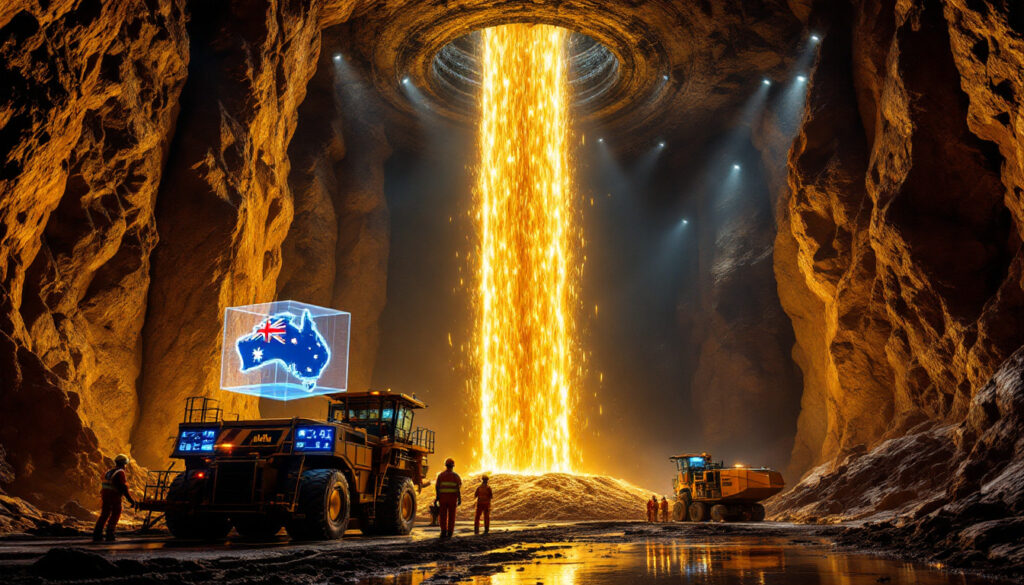Newmont's Tanami Gold Mine Expansion: Australia's Deepest Gold Shaft
The Tanami gold mine, situated in Australia's rugged Northern Territory, is undergoing a transformative expansion that will cement its position as one of the nation's premier gold producers. Newmont expands Tanami gold mine amid record gold prices through its ambitious Tanami Expansion 2 Project, which is set to create Australia's deepest gold production shaft, revolutionizing how this remote operation extracts its valuable mineral resources and setting new industry standards for efficiency and safety.
What is the Tanami Gold Mine?
The Tanami gold mine is a remote fly-in fly-out (FIFO) operation located on Warlpiri country, precisely 540 kilometers north-west of Alice Springs. This isolated mining complex has become one of Australia's most significant gold producers since Newmont took operational control. Currently producing approximately 400,000 ounces (over 11 tonnes) of gold annually, the mine has consistently delivered high-grade ore from its subterranean depths.
The operation's geological uniqueness sets it apart from other Australian mines. "Tanami's geology offers unique high-grade ore bodies at depth, unmatched in Australia's arid regions," explains Grant Brinkman, Newmont's Operations Manager. These exceptional deposits feature gold grades averaging 5.2g/t, significantly higher than the 1.5g/t found at comparable operations like Cadia Valley in New South Wales.
Mining at Tanami employs sub-level open stoping with backfill techniques, minimizing surface disruption while maximizing ore recovery. The site's carbon-in-leach processing plant achieves an impressive 94% recovery rate, extracting nearly all available gold from the mined rock. With estimated reserves of 8.5 million ounces remaining, the operation has secured at least two decades of future production at current rates.
How is Newmont expanding the Tanami mine?
The Tanami Expansion 2 Project
The cornerstone of Newmont's ambitious expansion is the construction of a vertical lifting shaft that plunges nearly 1,500 meters into the earth – equivalent to stacking four and a half Eiffel Towers underground. When completed, this engineering marvel will claim the title of Australia's deepest production shaft, representing a technological leap forward for the nation's mining industry.
The expansion incorporates a state-of-the-art mechanized underground crushing system utilizing Metso Outotec GP330 cone crushers with 500-tonne per hour capacity. This advanced setup is designed to process 3.8 million tonnes of ore annually, increasing production by an extra million tonnes per year compared to current capabilities.
With a total investment exceeding $2.3 billion, the Tanami Expansion 2 Project represents one of the most significant mining feasibility insights in Australia's recent history. The project is steadily progressing toward its expected completion by late 2026, with key milestones already achieved in shaft construction and surface infrastructure.
Key Engineering Innovations
The technological centerpiece of the expansion is the shaft hoisting system, capable of lifting 28 tonnes of crushed ore per skip – approximately the weight of a fully loaded semi-trailer. This revolutionary system transforms ore transport time from three hours via traditional truck haulage to just 2.5 minutes via the shaft, dramatically enhancing operational efficiency.
"The shaft eliminates 12 kilometers of underground truck routes, cutting diesel emissions by 40%," notes Suzanne Burke, Tanami's Haulage Supervisor. This emissions reduction aligns with Newmont's broader sustainability goals while also improving underground air quality for workers.
The shaft's construction employs specialized raise-boring technology using a Herrenknecht VB 10,000 rig, one of only a handful operating globally. Interestingly, 84 meters of the shaft sits above ground, housing the mechanical infrastructure required to operate this vertical transportation system.
The economic impact is equally impressive, with hoisting reducing ore movement costs from $12.50 to just $3.80 per tonne – a game-changer for the operation's financial performance. These savings make previously uneconomical deeper ore bodies financially viable, extending the mine's productive life significantly.
Why is gold mining booming in Australia?
Record Gold Prices
The Australian gold mining sector has experienced unprecedented growth, with exports reaching $27 billion in 2024 – an 18% increase year-over-year. This expansion has been fueled by extraordinary gold market analysis performance, with the precious metal breaking records over the past 12 months.
Gold reached an all-time high of $5,000 an ounce in early April 2025, creating exceptionally favorable conditions for producers. "Gold's role as a hedge against inflation drove 2025 price surges," explains Warren Pearce of the Minerals Council of Australia, highlighting how macroeconomic concerns continue boosting the metal's appeal.
The economics of gold mining in Australia have been further enhanced by currency dynamics. The Australian dollar's depreciation against the US dollar has added approximately $420 per ounce in additional margin for local producers, as gold is traded internationally in USD but produced at costs denominated in AUD.
Tanami's competitive position is strengthened by its remarkably low All-in Sustaining Cost (AISC) of $980 per ounce, well below the global average of $1,250. This cost advantage, combined with record prices, has made Newmont's substantial investment in expansion economically compelling, even as mining depths increase.
Other major operations are following suit, with Boddington Mine in Western Australia expanding throughput by 15% in 2024 to capitalize on favorable market conditions. The sector has also benefited from regulatory incentives, including Western Australia's royalty rebates for deep exploration, encouraging companies to pursue previously unexplored deposits.
How is technology improving mine safety and efficiency?
Safety Innovations
The Tanami expansion incorporates cutting-edge safety technologies that promise to transform underground operations. The new shaft system will significantly reduce underground road congestion, creating a safer work environment with improved visibility and reduced collision risks for the remaining truck operators.
AI-powered camera systems have already proven their worth during 2024 trials, cutting vehicle incidents by an impressive 62%. These technologies provide real-time monitoring and early warning capabilities, helping operators maintain situational awareness in challenging subterranean conditions.
Enhanced monitoring capabilities now extend to all underground operations, with data-driven approaches replacing traditional observation methods. The integration of IoT sensors throughout the mine generates 45 terabytes of information daily, enabling predictive maintenance and early hazard detection.
MineStar Fleet Control System
Tanami's operational nerve center is its MineStar Fleet Control System, a sophisticated digital twins in mining platform that automatically records and processes data from underground operations. The system handles up to 3,000 radio calls per day, streamlining communications and ensuring critical information is properly documented and acted upon.
"Real-time fatigue monitoring has reduced shift overruns by 33%," reveals Rachelle Pattermore, MineStar Implementation Lead. This improvement addresses one of mining's most persistent safety challenges – worker fatigue during long underground shifts.
The technology represents a significant step toward autonomous mining operations, with several Sandvik LH621 loaders already operating independently in blocked-out zones. Tanami's automation strategy draws lessons from Rio Tinto's AutoHaul program, adapting proven technologies to the unique challenges of underground gold mining.
By improving the speed and accuracy of operational data, MineStar reduces pressure on control room workers while enabling more informed decision-making. The system's cybersecurity protocols have been designed specifically for operational technology systems, protecting critical infrastructure from emerging digital threats.
What is life like for workers at the remote Tanami mine?
FIFO Worker Experience
Workers at Tanami operate on a 14-days-on, 7-days-off roster, living at Twin Hill Village during their rotation. This FIFO lifestyle has achieved a 78% retention rate – impressive for such a remote operation and testament to the quality of accommodations and support services provided.
The 600-bed village features comprehensive amenities, including a 24/7 medical clinic, recreation facilities, and 3G broadband connectivity. Despite these comforts, workers face unique challenges, particularly during their 12-hour underground shifts often conducted in complete darkness.
Each shift begins with comprehensive safety briefings, focusing on the specific hazards of subterranean work environments. Miners must navigate the psychological challenges of staying alert in narrow, dark tunnels, maintaining spatial awareness while operating powerful machinery in confined spaces.
Unlike some operations such as Olympic Dam, which offers family-friendly rosters, Tanami's extreme remoteness necessitates traditional FIFO arrangements. The company has responded by implementing dedicated mental health programs through the Fly-In Fly-Out Support Service, providing workers with psychological resources tailored to mining's unique stressors.
Indigenous Employment Program
One of Tanami's most successful initiatives is the "Yapa Crew" training program for local Indigenous workers. This program has trained 142 local community members in 2024 alone, offering comprehensive on-the-job training for heavy machinery operation and other mining skills.
"Mapping sacred sites during surveys connects us to Country while working," explains Mia Lechleitner, a Yapa Crew supervisor whose family has multi-generational ties to mining in the region. This cultural connection provides both employment opportunities and environmental stewardship for people from nearby communities.
The program builds intergenerational mining skills within Indigenous communities, creating sustainable career pathways in one of Australia's highest-paying sectors. Warlpiri Elders have praised the employment partnerships as a positive model for resource development on traditional lands, balancing economic opportunity with cultural respect.
What is the future outlook for the Tanami gold mine?
With the expansion project nearing completion, Tanami's future looks exceptionally promising. Further exploration is actively underway, particularly in the under-explored Western Shear Zone, where an estimated 4.8 million ounces of gold await discovery and development.
The potential 40-year mine life extension is supported by probable reserves that could maintain operations until 2065 at current production rates. "Tanami's expansion aligns with our 2040 net-zero commitment," Newmont's CEO recently confirmed, highlighting how the project fits within the company's broader sustainability strategy.
Environmental initiatives include a planned 70MW solar farm that will offset 45% of the operation's grid energy demand by 2027, significantly reducing carbon emissions while lowering power costs. Comprehensive closure plans include substantial rehabilitation bonds and detailed post-mining land use agreements developed in consultation with traditional owners.
Continued high gold prices support the operation's long-term viability, with analysts projecting sustained demand for the precious metal amid global economic uncertainties. The ongoing development of the local skilled workforce, particularly through Indigenous employment programs, ensures Tanami will remain a significant contributor to the Northern Territory's economy for decades to come.
Fosterville Mine in Victoria demonstrates how successful life extension can be achieved via high-grade exploration at depth, providing a model for Tanami's future development strategy. With its combination of technological innovation, geology of ore deposits, and community engagement, Newmont expands Tanami gold mine amid record gold prices while positioning it to remain one of Australia's premier gold producers well into the future.
FAQ: Newmont's Tanami Gold Mine Expansion
How deep will the new Tanami mine shaft be?
The new shaft will be nearly 1,500 meters deep, making it the deepest production shaft in Australia when completed. This depth is equivalent to stacking four and a half Eiffel Towers underground.
How much gold does the Tanami mine currently produce?
The mine currently produces approximately 400,000 ounces (more than 11 tonnes) of gold annually, with an estimated 8.5 million ounces in remaining reserves.
When will the Tanami Expansion 2 project be completed?
The expansion project is expected to be completed by late 2026, with several key milestones already achieved in shaft construction and surface infrastructure development.
How much has Newmont invested in the Tanami expansion?
Newmont has invested more than $2.3 billion in the expansion project, making it one of the most significant mining infrastructure investments in Australia's recent history.
What are the current gold prices?
Gold prices reached a record high of $5,000 an ounce in early April 2025, contributing to the economic viability of the expansion and supporting Australia's booming gold and silver strategies sector, which generated $27 billion in exports during 2024.
Ready to Spot the Next Major ASX Gold Discovery?
Discovery Alert's proprietary Discovery IQ model analyses ASX announcements to provide instant notifications when significant mineral discoveries like Tanami occur, giving subscribers a critical market advantage. Visit the Discovery Alert discoveries page to see how historic gold discoveries have delivered exceptional returns and start your 30-day free trial today.




